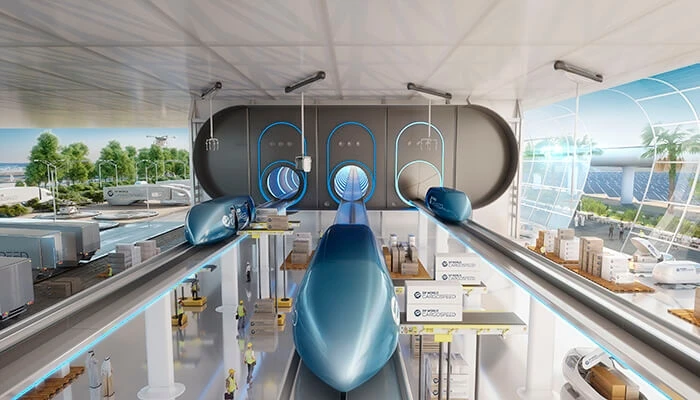& Construction

Integrated BIM tools, including Revit, AutoCAD, and Civil 3D
& Manufacturing

Professional CAD/CAM tools built on Inventor and AutoCAD
When ancient civilizations invented the wheel, they unlocked millennia of future transportation innovations: chariots, bicycles, trains, automobiles, and even airplanes. Each new mode made it possible to transport goods and people farther, faster.
A new generation of transportation innovators is imagining what mobility technology might look like without that wheel. To them, the next major transportation disruption won’t roll at all—it will levitate. It’s called Hyperloop, and it promises to redefine not just travel, but the way cities and suburbs evolve.
Imagine moving at the speed of air travel but on the ground, zooming between cities linked like metro stops: Hyperloop technology transports people and cargo—at speeds up to 670 miles per hour—in floating, subway-style “pods” that use electric motors and magnetic levitation to glide through depressurized tubes that can be built underground, above ground on elevated pylons, or even underwater.
Hyperloop advantages don’t stop at speed: The technology consumes a fraction of the power required for traditional transit, with zero direct emissions. Travel is point-to-point, on demand, and unaffected by weather or traffic.
Think this kind of travel is a futuristic fantasy? Think again. Virgin Hyperloop, one of the start-ups vying to lead the Hyperloop revolution, has successfully tested its technology at scale and says Hyperloop travel will be a reality within this decade.
Investor and entrepreneur Shervin Pishevar, who conceived the Hyperloop idea alongside Elon Musk, established Virgin Hyperloop in 2013. The company was originally called Hyperloop Technologies Inc., adopting its current moniker in 2020, a few years after Sir Richard Branson’s Virgin Group made a strategic investment. The company is steadily advancing toward real-world operations, with projects currently underway in the United States, India, and the Middle East.
Hyperloop could change the way people travel, live, and work. Consider these journey times: Today, it takes four hours and 17 minutes by car or one hour and a half by plane (not counting transfers) to travel from Los Angeles to Las Vegas, and it takes five hours by car or one hour and 20 minutes by plane to get from Chicago to St. Louis. Aboard Virgin Hyperloop, those trips could be reduced to just 30 minutes and 33 minutes, respectively.
“You could live in Las Vegas and work in downtown Los Angeles, and you’d get to work quicker than driving there from Santa Monica,” says Ismaeel Babur, a senior civil engineer at Virgin Hyperloop. The depressurized tube infrastructure will also make Hyperloop more convenient than other transit; passengers summon pods at will and reach their destination without making stops along the way. “When you want to catch a Hyperloop, you’ll be able to get it within less than five minutes.”
The social implications are massive. If people no longer have to live near their jobs, they could move to more remote communities with lower costs, better education, cleaner air, and a higher quality of life. In the cities they leave behind, residents will enjoy many of those same benefits thanks to reduced population density: less pollution, less congestion, and lower housing prices. For both groups, positive outcomes might include better physical health, improved financial well-being, higher educational attainment, increased employment, and even happier marriages.
“When you really think about it, you can start to see all the possibilities,” says Babur, who predicts developers will flock to communities connected by Hyperloop, creating economic benefits on top of social ones. “You will have cities that will become more developed just because the Hyperloop is connecting them.”
Making Hyperloop a reality means overcoming both technical and regulatory challenges. To address technical hurdles, the company is taking a strategic approach to design. In November 2019, it announced a partnership with Autodesk, using Autodesk software (including Civil 3D, InfraWorks, Revit, and Inventor) to optimize design, construction, operations, and maintenance of the Hyperloop track. By bringing real-world context into all phases of the project lifecycle to enable better decisions and by adopting seamless cloud collaboration (using Autodesk’s BIM 360 project-delivery platform), Virgin Hyperloop is propelling the Hyperloop industry forward while delivering ancillary benefits to more traditional forms of transportation, such as railway and highway route optimization.
Technical challenges begin with customer safety and comfort. To make Hyperloop comfortable, engineers must carefully consider system alignment—the horizontal and vertical lines Hyperloop traces between stops.
“We use really conservative passenger comfort numbers to determine the minimum curvature,” Babur says. System engineers use coffee as a barometer, making calculations to ensure passengers’ cups will stay upright through curves. “We try to ensure that when you’re riding the Hyperloop, your coffee will never slide.”
Windows also affect passenger comfort, which is why Virgin Hyperloop isn’t planning on them. “When you’re traveling 500 to 700 miles per hour in the air, you have a good, long perspective of what you see,” Babur says. “But when you have that speed close to the ground you can get really sick if you look out the window.”
Physics can be an engineering handicap but also an engineering advantage. With high-speed rail, for example, trains traveling at top speeds can climb grades of maximum 3%, which—absent expensive tunneling—limits the routes they can travel through mountainous terrain. Hyperloop, on the other hand, can climb grades of up to 10% at top speed.
When it completed the world’s first full-system Hyperloop trial in 2017 near Las Vegas, Virgin Hyperloop proved itself capable of solving the significant technical challenges. Going forward, it still must overcome another formidable set of obstacles: government regulations.
Because Hyperloop is a new technology, industry and government must develop regulations from scratch. Step one will be building a Hyperloop Certification Center where stakeholders can collaborate to establish safety standards, research frameworks, and test the first Hyperloop passenger product in the United States. Already, 17 states have submitted formal responses.
Reuters reports that passengers could be riding the test track by 2025 and operational Hyperloop routes by 2029. Although regulatory processes rarely go as quickly or as smoothly as planned, Babur is optimistic. “There’s a little bit more red tape in the US than in other countries,” he says. “But once you start getting momentum going through that red tape, it’s unstoppable.”
September 2020 update: Regulatory momentum in the United States has been rapidly progressing. USDOT Secretary Elaine Chao unveiled the regulatory guidance document for Hyperloop, establishing that the new mode of transit will fall under the purview of the Federal Railroad Administration (FRA) and that projects are eligible for federal funding.
Matt Alderton is a Chicago-based freelance writer specializing in business, design, food, travel, and technology. A graduate of Northwestern University's Medill School of Journalism, his past subjects have included everything from Beanie Babies and mega bridges to robots and chicken sandwiches. He may be reached via his website, MattAlderton.com.
Executive insights
AECO
Executive insights








